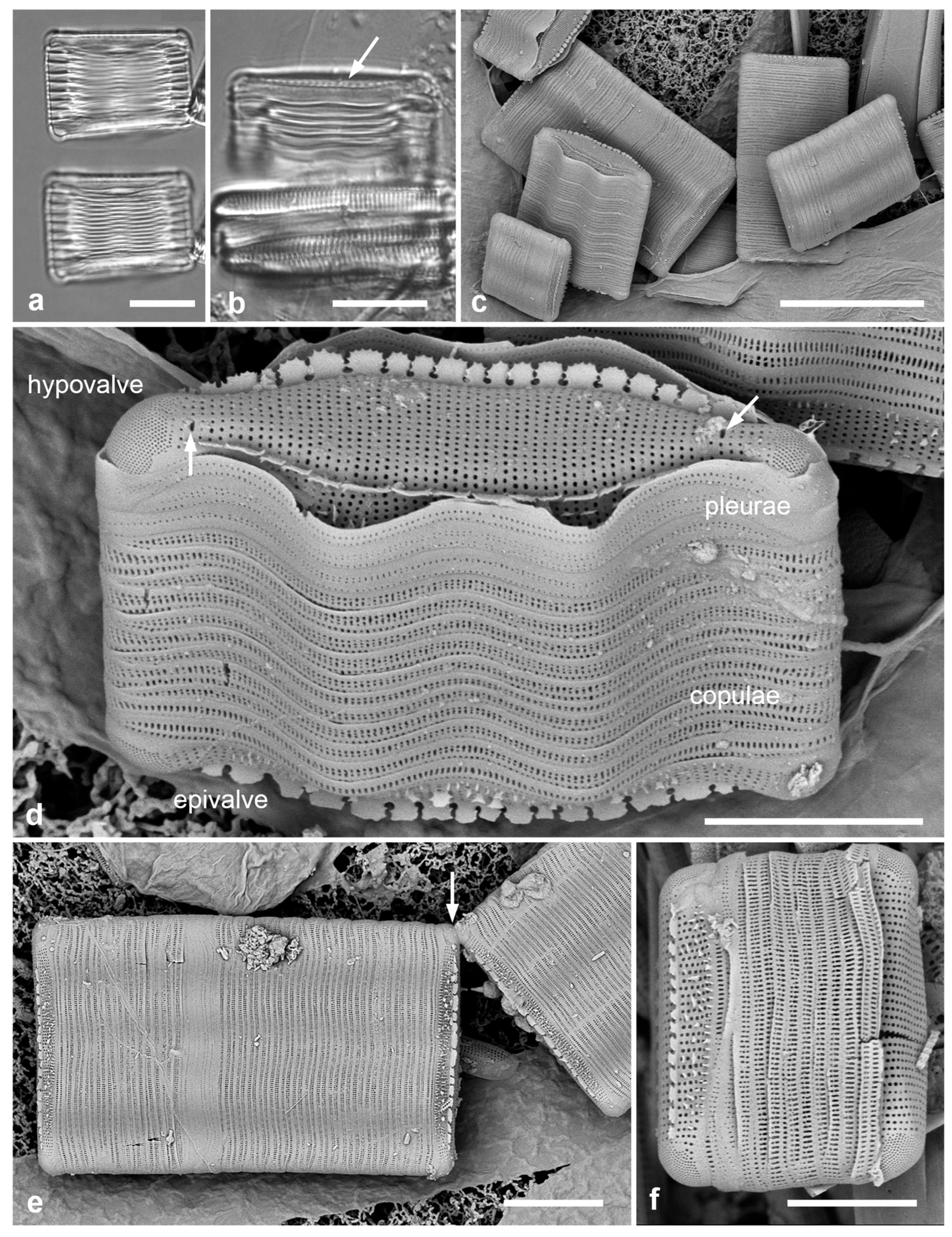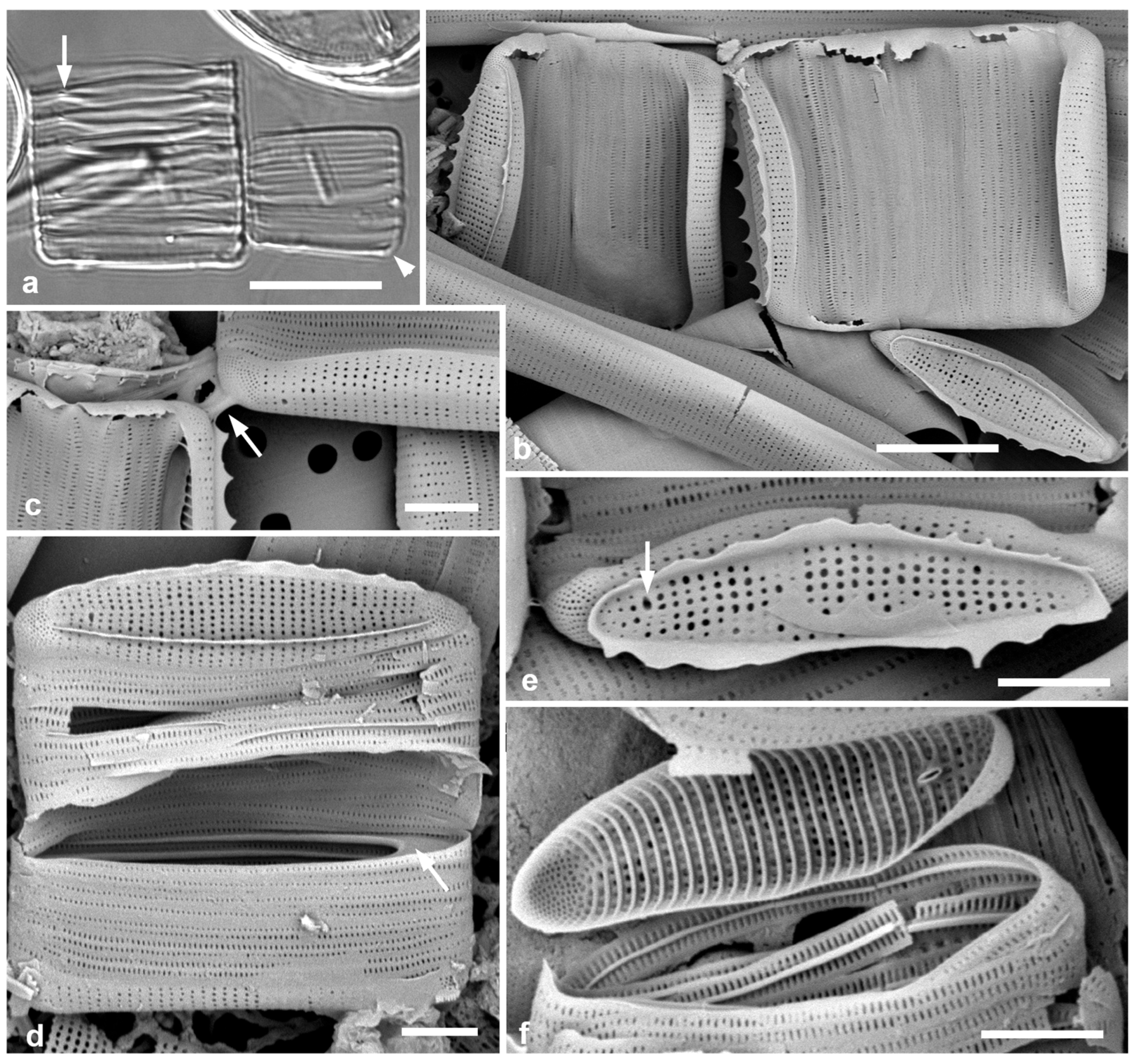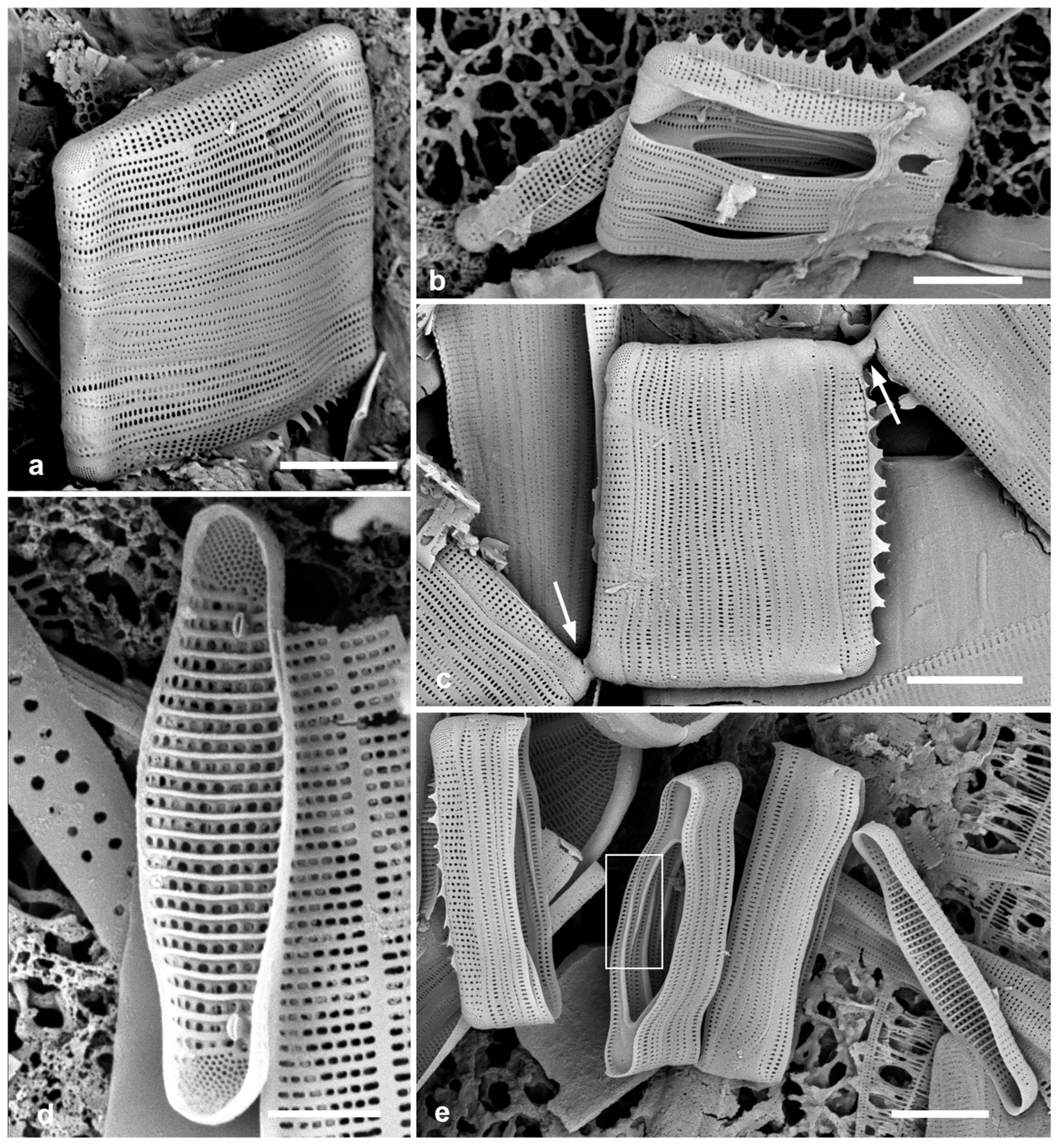Hyalosira (Diatomeae: Grammatophoraceae) from Florida Keys, U.S.A., Including Two New Species with Consistent Ornamentation †
Abstract
1. Introduction
2. Materials and Methods
3. Results
Grammatophoraceae Lobban & Ashworth
Hyalosira Kützing emend. Lobban, Ashworth and Majewska
3.1. Hyalosira ornata sp. nov.—Figure 1 and Figure 2


3.2. Hyalosira sertifera sp. nov.—Figure 3
3.3. Hyalosira hesperia Álvarez-Blanco & Blanco Emend Bizsel & S.Blanco.—Figure 3a and Figure 4


| Characters | H. ornata, sp. nov. | H. hesperia Mediterranean | H. hesperia Florida | H. pacifica | H. sertifera sp. nov. | H. tropicalis | H. septata | H. faba | H. navarroana | H. mixta | H. triseriata | H. obtusata [delicatula] **** | H. parietina |
|---|---|---|---|---|---|---|---|---|---|---|---|---|---|
| Substratum | epiphytic | epilithic, epiphytic | epiphytic | epiphytic | epiphytic | epiphytic | epizoic | epizoic | epiphytic | epiphytic | epiphytic | epiphytic | unknown |
| Shape in valve view | undulate | linear to weakly inflated, rostrate to weakly capitate | linear to weakly inflated, rostrate to weakly capitate | lanceolate, rostrate to capitate | elliptical, weakly rostrate | oval to lanceolate, inflated, rostrate to capitate | linear to weakly inflated, rostrate to weakly capitate | lanceolate | lanceolate, weakly rostrate | lanceolate, apices rounded or subcapitate | lanceolate, weakly rostrate | linear to linear-lanceolate | oval |
| Length × width, µm | 16–24 × 6–8 | 14–19 × 3–4 | 7–20 × 3 | 9–23 × 3–5 | 9–16 × 3–4 | 14–16 × 6–8 | 10–23 × 2.5–3.5 | 4.5–16 × 2.2–3.0 | 9–47 × 3–5 | 10–31 (4.5–15) × 3–4 (2.2) *** | 7–24 × 3.3–4.2 | 6–12 × 2.1–3.8 [3–20 × 1.5–3.5] | 6–9 × 2.5–3.5 |
| Stria density/10 µm | 34–36 | 27–29 | 28–32 | 22–24 | 38–40 | 20–22 | 36–38 | 27–32 | 24–27 | 25–27 (24–30) | 22–23 | [22–30] | 33 |
| Stria character | uniseriate | uniseriate | uniseriate | uniseriate | uniseriate | uniseriate, areolae various diameters, generally large | biseriate throughout | Biseriate except for row of reniform areolae along sternum | biseriate on mantle, uniseriate on valve face | biseriate except triseriate at distal end | triseriate throughout | uniseriate throughout | unknown |
| Rimoportulae per valve | 2 | 2 | 2 | 2 | 1 | 1 | 1 | 1 | 1 | 1 | 1 | 1 | unknown |
| Cristae | line of spiky, circular elements on marginal costa plus shards and spines lower on mantle | variable up to extensive flaps on only one valve | apparently inconsistent flaps from continuous base on only one valve | prominent flaps from continuous base | sturdy “garland” from continuous base on only one valve | often prominent when present (one valve) | elaborate and extensive (one valve) | prominent when present, continuous almost to apices | row of mostly separate flakes along edge of valve face and onto pore fields | poorly developed | continuous line of silica with triangular ridges, both valves | prominent when present | unknown |
| Copula striae/10 µm * | 55–58 | 40–44 | 42–50 | 31–34 | 70–73 | approx. 45 | approx. 65 | approx. 50 | approx. 50 | approx. 42 (60) | approx. 65 | approx. 46 | unknown |
| Septa relative dimensions ** | |||||||||||||
| Approx. depth (see Figure 2e) | 14% | 25% | 27% | 25% | 10% when present | very shallow | to 30% | very shallow | very shallow | absent | unknown | shallow or absent | unknown |
| Thickened midrib | >95% | 65% | 65% | 65% | 90% | 90% | |||||||
| Reference | this paper | [15] | this paper | [15] | this paper | [14] | [14] | [14] | [14] | [14] | [13,14] | [17] |
4. Discussion
5. Key to Species of Hyalosira Known to Date from SEM
| 1. Frustules arcuate in girdle view, heterovalvar: different concave and convex valves | H. flexa |
| 1. Frustules flat in girdle view axis, tabular | 2 |
| 2. Valve outline undulate, both valves highly ornamented, copulae septate | H. ornata |
| 2. Valve outline elliptical to linear; ornamentation consistently on only one valve, inconsistent, or absent; copulae ± septa | 3 |
| 3. Prominent septum filling closed end of ordinary copulae (VC may be different) (visible in LM) | 4 |
| 3. Septa shallow or absent | 6 |
| 4. Striae bi- or multiseriate at least in part, one rimoportula | H. septata |
| 4. Striae uniseriate, two rimoportulae per valve | 5 |
| 5. Striae relatively coarse on both valve and copulae (22–24 and 31–34 in 10 µm, respectively) | H. pacifica |
| 5. Striae finer on valve and copulae (27–32 and 40–50 respectively) | H. hesperia |
| 6. Striae bi- or multiseriate at least in part | 7 |
| 6. Striae uniseriate throughout | 8 |
| 7. Biseriate on mantle, uniseriate on valve face and upper mantle | H. navarroana |
| 7. Biseriate except for row of bean-like areolae along sternum | H. faba |
| 7. Biseriate on mantle and valve face except triseriate at mantle edge | H. mixta |
| 7. Triseriate throughout | H. triseriata |
| 8. Small cells (14–16 µm long) with coarse striae 20–25/10 µm | H. tropicalis |
| 8. Very small cells with fine striae ≥ 30/10 µm | 9 |
| 9. Valve striae 30–32/10 µm, copula striae ca. 44/10 µm; irregular ornamentation | H. obtusangula |
| 9. Valve striae 38–40/10 µm, copula striae 70–73/10 µm; ornamentation a consistent “garland” on one valve; shallow septa on at least some copulae | H. sertifera |
Funding
Institutional Review Board Statement
Data Availability Statement
Acknowledgments
Conflicts of Interest
Abbreviations
| LM | Light microscopy |
| SEM | Scanning electron microscopy |
References
- Bryłka, K.; Alverson, A.; Pickering, R.A.; Richoz, S.; Conley, D.J. Uncertainties surrounding the oldest fossil records of diatoms. Sci. Rep. 2023, 13, 8047. [Google Scholar] [CrossRef] [PubMed]
- Guiry, M.D. How many species of algae are there? A reprise. Four kingdoms, 14 phyla, 63 classes and still growing. J. Phycol. 2024, 60, 214–228. [Google Scholar] [CrossRef] [PubMed]
- Mann, D.G.; Vanormelingen, P. An inordinate fondness? The number, distributions, and origins of diatom species. J. Euk. Microbiol. 2013, 60, 414–420. [Google Scholar] [CrossRef] [PubMed]
- MacGillivary, M.E.; Kaczmarska, I. Genetic differentiation within the Paralia longispina (Bacillariophyta) species complex. Botany 2012, 90, 205–222. [Google Scholar] [CrossRef]
- Gastineau, R.; Davidovich, N.; Hansen, G.; Rines, J.; Wulff, A.; Kaczmarska, I.; Ehrman, J.; Hermann, D.; Maumus, F.; Hardivillier, Y.; et al. Haslea ostrearia-like diatoms: Biodiversity out of the blue. In Advances in Botanical Research, Volume 71: Sea Plants; Bourgougnon, N., Ed.; Academic Press: Cambridge, MA, USA; Elsevier: New York, NY, USA, 2014; pp. 441–446. [Google Scholar]
- Sterrenburg, F.A.S.; Tiffany, M.A.; Hinz, F.; Herwig, W.E.; Hargraves, P.E. Seven new species expand the morphological spectrum of Haslea. A comparison with Gyrosigma and Pleurosigma (Bacillariophyta). Phytotaxa 2015, 207, 143–162. [Google Scholar] [CrossRef]
- Majewska, R.; Bosak, S.; Frankovich, T.A.; Ashworth, M.P.; Sullivan, M.J.; Robinson, N.J.; Lazo-Wasem, E.A.; Pinou, T.; Nel, R.; Manning, S.R.; et al. Six new epibiotic Proschkinia (Bacillariophyta) species and new insights into the genus phylogeny. Eur. J. Phycol. 2019, 54, 609–663. [Google Scholar] [CrossRef]
- Sims, P.A.; Ashworth, M.P.; Theriot, E.C.; Manning, S.R. Molecular and morphological analysis of Biddulphia sensu lato: A new diagnosis of Biddulphia, with a description of the new genera Biddulphiella and Neobrightwellia. Mar. Micropaleontol. 2023, 178, 102186. [Google Scholar] [CrossRef]
- Kützing, F.T. Die Kieselschaligen Bacillarien oder Diatomeen; W. Köhne: Nordhausen, Germany, 1844; pp. [i-vii], [1]–152, pls 1–30. [Google Scholar]
- Van Heurck, H. Synopsis des Diatomées de Belgique Atlas; Ducaju et Cie: Anvers, Belgium, 1881; pls XXXI-LXXVII [31-77]. [Google Scholar]
- Round, F.E.; Crawford, R.M.; Mann, D.G. The Diatoms: Biology and Morphology of the Genera; Cambridge University Press: Cambridge, UK, 1990; 747p. [Google Scholar]
- Navarro, J.N.; Williams, D.M. Description of Hyalosira tropicalis sp. nov. (Bacillariophyta) with notes on the status of Hyalosira Kützing and Microtabella Round. Diatom. Res. 1991, 6, 327–336. [Google Scholar] [CrossRef]
- Hustedt, F. Die Kieselalgen Deutschlands, Österreichs und der Schweiz. In Dr. L. Rabenhorst’s Kryptogamen-Flora, Band 7, Teil 2, Part 1; Akademischen Verlagsgesellschaft: Frankfurt am Main, Germany, 1931. [Google Scholar]
- Lobban, C.S.; Majewska, R.; Ashworth, M.; Bizel, N.; Bosak, S.; Kooistra, W.H.C.F.; Lam, D.W.; Navarro, J.N.; Pennesi, C.; Sato, S.; et al. Diatom genus Hyalosira (Rhabdonematales emend.) and resolution of its polyphyly in Grammatophoraceae and Rhabdonemataceae with a new genus, Placosira, and five new Hyalosira species. Protist 2021, 172, 125816. [Google Scholar] [CrossRef] [PubMed]
- Lobban, C.S.; Bizsel, N.; Blanco, S. Rimoportula distribution, heterovalvy and heteropolarity in Hyalosira (Bacillariophyta: Rhabdonematales), with revision of H. hesperia and two new species. Protist 2022, 173, 125869. [Google Scholar] [CrossRef] [PubMed]
- Lobban, C.S. Towards a biogeography of Mastogloia (Diatomeae: Bacillariophyceae): A preliminary checklist for Yap, Micronesia, with new ultrastructure images and a review of problems. Nova Hedwigia 2025, 120, 313–417. [Google Scholar] [CrossRef]
- Witkowski, A.; Lange-Bertalot, H.; Metzeltin, D. Diatom Flora of Marine Coasts I; Icon. Diatomol. 7; Gantner Verlag: Ruggell, Germany, 2000; 925p. [Google Scholar]
- Lobban, C.S.; Ashworth, M.P. Hanicella moenia gen. et sp. nov., a ribbon-forming diatom (Bacillariophyta) with complex girdle bands, compared to Microtabella interrupta and Rhabdonema cf. adriaticum: Implications for Striatellales, Rhabdonematales and Grammatophoraceae, fam. nov. J. Phycol. 2014, 50, 860–884. [Google Scholar] [CrossRef] [PubMed]
- Cox, E.J. Girdle band structure in the diatom genus Proschkinia (Bacillariophyta)—Another potential adaptation to stabilise a deep cingulum? Diversity 2023, 15, 734. [Google Scholar] [CrossRef]
- Vogel, S. Life in Moving Fluids: The Physical Biology of Flow, 2nd ed.; Princeton U. Press: Princeton, NJ, USA, 1994. [Google Scholar]
- Ashworth, M.P.; Majewska, R.; Frankovich, T.A.; Sullivan, M.; Bosak, S.; Filek, K.; Van de Vijver, B.; Arendt, M.; Schwenter, J.; Nel, R.; et al. Cultivating epizoic diatoms provides insights into the evolution and ecology of both epibionts and hosts. Sci. Rep. 2022, 12, 15116. [Google Scholar] [CrossRef] [PubMed]
- Totti, C.; Romagnoli, T.; De Stefano, M.; Camillo, D.C.G.; Bavestrello, G. The diversity of epizoic diatoms. In All Flesh Is Grass. Cellular Origin, Life in Extreme Habitats and Astrobiology; Dubinsky, Z., Seckbach, J., Eds.; Springer: Dordrecht, Germany, 2010; Volume 16. [Google Scholar] [CrossRef]
- Riaux-Gobin, K.; Ashworth, M.P.; Kociolek, J.P.; Chevallier, D.; Saenz-Agudelo, P.; Witkowski, A.; Daniszewska-Kowalczyk, G.; Gaspar, C.; Lagant, M.; Touron, M.; et al. Epizoic diatoms on sea turtles and their relationship to host species, behaviour and biogeography: A morphological approach. Eur. J. Phycol. 2021, 56, 359–372. [Google Scholar] [CrossRef]
- Frankovich, T.A.; Wachnicka, A. Epiphytic diatoms along phosphorus and salinity gradients in Florida Bay (Florida, USA), an illustrated guide and annotated checklist. In Microbiology of the Everglades Ecosystem; Entry, J.A., Gotlieb, A.D., Jayachandran, K., Ogram, A., Eds.; CRC Press: Boca Raton, FL, USA, 2015; pp. 239–286. [Google Scholar]
- Sterrenburg, F.A.S. Studies on the genera Gyrosigma and Pleurosigma (Bacillariophyceae) Gyrosigma balticum, (Ehrenberg) Rabenhorst, G. pensacolae sp. n. and simulacrum species. Bot. Mar. 1995, 38, 401–408. [Google Scholar] [CrossRef]
Disclaimer/Publisher’s Note: The statements, opinions and data contained in all publications are solely those of the individual author(s) and contributor(s) and not of MDPI and/or the editor(s). MDPI and/or the editor(s) disclaim responsibility for any injury to people or property resulting from any ideas, methods, instructions or products referred to in the content. |
© 2025 by the author. Licensee MDPI, Basel, Switzerland. This article is an open access article distributed under the terms and conditions of the Creative Commons Attribution (CC BY) license (https://creativecommons.org/licenses/by/4.0/).
Share and Cite
Lobban, C.S. Hyalosira (Diatomeae: Grammatophoraceae) from Florida Keys, U.S.A., Including Two New Species with Consistent Ornamentation. Diversity 2025, 17, 448. https://doi.org/10.3390/d17070448
Lobban CS. Hyalosira (Diatomeae: Grammatophoraceae) from Florida Keys, U.S.A., Including Two New Species with Consistent Ornamentation. Diversity. 2025; 17(7):448. https://doi.org/10.3390/d17070448
Chicago/Turabian StyleLobban, Christopher S. 2025. "Hyalosira (Diatomeae: Grammatophoraceae) from Florida Keys, U.S.A., Including Two New Species with Consistent Ornamentation" Diversity 17, no. 7: 448. https://doi.org/10.3390/d17070448
APA StyleLobban, C. S. (2025). Hyalosira (Diatomeae: Grammatophoraceae) from Florida Keys, U.S.A., Including Two New Species with Consistent Ornamentation. Diversity, 17(7), 448. https://doi.org/10.3390/d17070448






